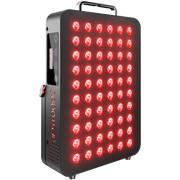Intersection of Red Light Therapy and Mental Health:
When it comes to depression, if you haven't really seen or experienced it, it's hard to know the pain and understand the severity of the disease. Depression is a mental illness characterized by a significant and persistent depressed mood, and neuromodulation techniques also play an important role in the treatment of depression in addition to medication and psychotherapy. Many studies have shown that photobiomodulation (PBM), especially red and near-infrared light therapy, can treat depression and has unique advantages over traditional treatments.
Red light therapy (RLT) is a phototherapy method that prevents and treats diseases through light irradiation at different durations and intensities. RLT can effectively alleviate mental disorders[1] and reduce residual symptoms, and it has a good application prospect in the treatment of depression.

Red light therapy (RLT) as a complementary treatment for depression:
In the treatment landscape of depression, traditional antidepressant medications frequently require weeks to effectively demonstrate their effects. Unfortunately, this delay can engender increased risks for the individual, as he or she faces continued depressive symptoms or self-destructive behaviors before finally experiencing relief. Some of these patients, however, may tend to prematurely terminate medication on the assumption of ineffectiveness, thus worsening their state. By promoting both physiological and neurological health, [2], it serves as the perfect adjunctive therapy to be used in combination with standard practices in order to treat depression from all possible angles, physically and mentally. It regulates the neurotransmitter's mitochondrial functions and enhances neuronal activity. This makes RLT appealing to individuals seeking an increased level of symptom relief and overall well-being that is unburdened by the common adverse reactions of so many pharmacological treatments because of its non-invasiveness, flexibility, and practically no side effects.
Key Benefits of RLT in the Battle Against Depression:
- Mood improvement: RLT may enhance mood by altering neurotransmitter activity, including serotonin and dopamine levels.[3] It contributes to better emotional states and helps reduce the symptoms of depression.
- Inflammation Reduction: RLT has been demonstrated to significantly reduce systemic inflammation, which is associated with depression, likely mitigating depression and improving overall well-being.
- Mitochondrial Support: Mitochondrial function is enhanced by RLT, [4] which may boost the level of energy in cells, help reduce the feelings of fatigue and lethargy associated with depression, and restore a sense of vitality.
- Circulatory improvements: RLT enhances better blood flow and oxygenation, particularly to the brain. Circulation promotes good mood and improvement in cognitive functions; hence, it is integral to mood stability.
- Regulating sleep quality: Resting is one of the most critical factors in the occurrence of depression. With circadian rhythm support, RLT can help regulate a better quality of sleep pattern through general relaxation and, thus, directly improve mood.

Real-life Application Scenarios for RLT in Depression Management:
Researchers conducted a clinical trial to determine how well red light therapy worked in bipolar depression when combined with an antidepressant. The participants were randomly assigned to receive either a red light or an antidepressant for eight weeks. Patients with RLT had significantly better depression scores at four and eight weeks than the control group.[5] Given the evidence, RLT was judged to have reliable effectiveness and safety, with potential as an adjunct therapy in real-life clinical settings for bipolar depression.
Incorporating RLT into a Holistic Approach to Depression:
- Prioritize Sleep: Make a regular schedule and develop a calming bedtime routine. Consider incorporating RLT sessions in the evenings to facilitate relaxation and enhance sleep quality.
- Stress management: Use mindfulness meditation, deep breathing, and gentle yoga to manage stress. Enhance this practice with RLT to help with relaxation and mood control.
- Exercise Often: Participate in an activity, like walking, jogging, yoga, or similar, which increases mood and decreases symptoms of depression. Consider mixing in RLT sessions before or after exercise to capture the best of both therapies.
- Consult a Mental Health professional: Talk with your therapist or psychiatrist about how to incorporate RLT into your individual treatment plan. Make suggestions for the frequency, duration, and time of RLT sessions appropriate for your individual needs and treatment goals.
- Track Progress: Monitor the changes in mood, energy levels, and sleep patterns with this holistic approach to using RLT in depression. Share those changes with the mental health professionals to follow along in their treatment plan with RLT.
Conclusion
Among the plethora of treatments that exist for depression, red light therapy offers some rays of hope. Its mild, non-invasive approach and the broad spectrum of potential benefits relieve those suffering from mental conditions. One can reach its therapeutic potential very easily when this is integrated seamlessly with a holistic treatment plan that includes traditional treatments like therapy and medication. Each session with RLT is like a ray of sunshine and the promise of a future where hope and healing go hand in hand.
References
[1] Glass G. E. (2021). Photobiomodulation: The Clinical Applications of Low-Level Light Therapy. Aesthetic surgery journal, 41(6), 723–738. https://doi.org/10.1093/asj/sjab025
[2] Shirkavand, A., Akhavan Tavakoli, M., & Ebrahimpour, Z. (2023). A Brief Review of Low-Level Light Therapy in Depression Disorder. Journal of lasers in medical sciences, 14, e55. https://doi.org/10.34172/jlms.2023.55
[3] Brouwer, A., van Raalte, D. H., Nguyen, H. T., Rutters, F., van de Ven, P. M., Elders, P. J. M., Moll, A. C., Van Someren, E. J. W., Snoek, F. J., Beekman, A. T. F., & Bremmer, M. A. (2019). Effects of Light Therapy on Mood and Insulin Sensitivity in Patients With Type 2 Diabetes and Depression: Results From a Randomized Placebo-Controlled Trial. Diabetes care, 42(4), 529–538. https://doi.org/10.2337/dc18-1732
[4] Yeager, R. L., Oleske, D. A., Sanders, R. A., Watkins, J. B., 3rd, Eells, J. T., & Henshel, D. S. (2007). Melatonin as a principal component of red light therapy. Medical hypotheses, 69(2), 372–376. https://doi.org/10.1016/j.mehy.2006.12.041
[5] Cuomo, A., Carmellini, P., Garo, M. L., Barillà, G., Libri, C., Spiti, A., Goracci, A., Bolognesi, S., & Fagiolini, A. (2023). Effectiveness of light therapy as adjunctive treatment in bipolar depression: A pilot study. Journal of affective disorders, 321, 102–107. https://doi.org/10.1016/j.jad.2022.10.009














 Small
Small

 Moderate
Moderate

 Moderate
Moderate

 Moderate
Moderate

 Full
Full



